




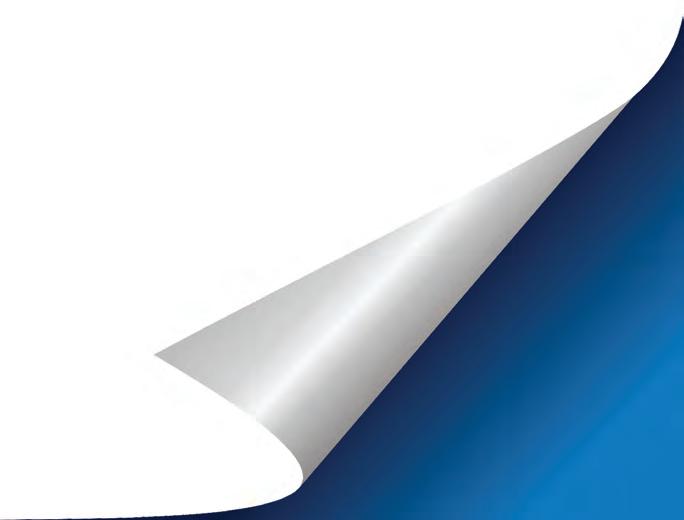
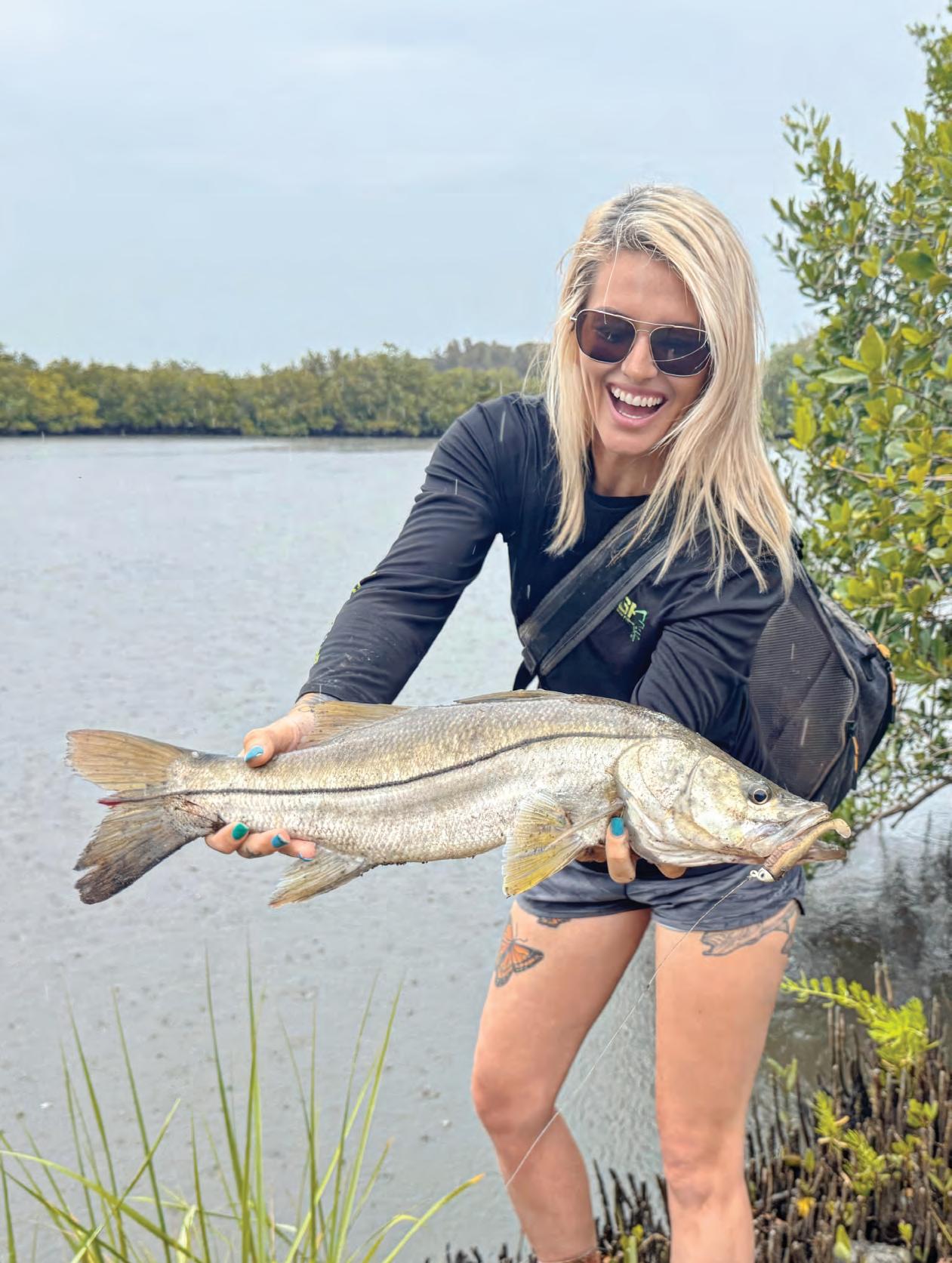



You want new charts?
You got new charts! Explore the ocean with vibrant terrain & depth shading, using all-new TZ MAPS. Don’t just take our word for it. See for yourself. Scan here, and we’ll show you!
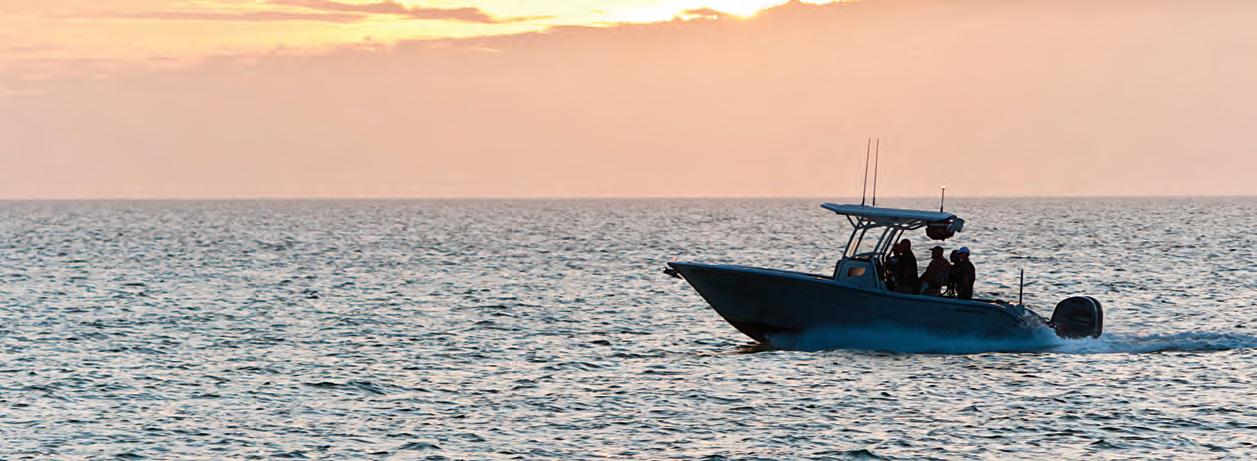
Are you ready to embark on your next on-water adventure? Before you set sail, here are fve things to know about boat insurance.
1. Boat insurance isn’t just for accidents
With comprehensive coverage, you’ll also be protected fnancially for theft, vandalism, and unexpected events like storms if you need repairs or replacements due to damage.
2. Accidents can happen to anyone
When accidents happen, boat insurance offers liability coverage for damages or injuries you cause while boating, up to specifed limits. It can also cover lawsuit costs if you’re sued.
3. Boat insurance can cover medical payments
Boat insurance offers a range of optional medical payments coverage limits, helping to cover medical expenses if you’re in an accident or someone is hurt on your boat, regardless of fault.
4. Most lenders require boat insurance
If you fnanced your boat, you’ll likely need boat insurance since most lenders require boat insurance to protect their investment. Additionally, some marinas or municipalities require proof of insurance for docking.
5. Progressive offers specialized boat coverages
Ever worry about getting stuck on the water?
Progressive’s Sign & Glide® On-Water Towing coverage** can help. It’s an additional coverage that steps in if your boat is disabled or breaks down on the water, paying for on-water towing, jump starts, soft ungroundings, and fuel delivery. Fuel cost isn’t included.
Don’t let unforeseen circumstances disrupt your voyage. Cruise with confdence thanks to Progressive Boat insurance. Because when it comes to your boat, peace of mind is the ultimate luxury.
Scan to get a quote in as little as 4 minutes.
to learn more.




















By Skye Burkhardt

In recent years, paddleboard !shing has quietly emerged as one of the most immersive and rewarding ways to !sh, particularly in the backwaters where nature whispers and big !sh lurk in shallow, untouched waters. Combining the stealth of a kayak with the freedom and perspective of stand-up paddling, paddleboard !shing o ers a unique experience that connects anglers to their environment in a deeply personal way. You become part of the environment—just another element in a quiet, dynamic system. Every ripple matters, every shadow could be a !sh. It’s !shing stripped to its essentials: a board, a rod, and your wits.
Backwaters—those slow-moving or stagnant tributaries and tidal creeks separated from larger bodies of water—are havens for !sh and wildlife. ey’re o en shallow, weedy, and di cult to access with motorboats, making them ideal for paddleboards. ese secluded waterways harbor species like red!sh, snook, bass, tarpon, and trout, depending on your region. e calm water allows for sight !shing and careful stalking, while the surrounding vegetation provides natural structure and cover for !sh. For anglers seeking peace, solitude, and the thrill of spotting and targeting !sh in crystal-clear shallows, backwaters are unmatched.
Paddleboards o er several distinct advantages in the backwaters:
• Maneuverability: ey can access shallow and narrow areas where boats can’t go.
• Stealth: Paddleboards glide silently, allowing
you to approach !sh without disturbing them.
• Sight Fishing: Standing gives anglers a better vantage point to see !sh and structure below the surface.
• Portability: Easy to transport and launch, paddleboards can be carried to remote areas with little e ort.
• Minimal Impact: Paddleboards have a low environmental footprint, making them a great choice for conservation-minded anglers.
Fishing from a paddleboard requires packing smart. Space is limited, so prioritize:
• Rod and Reel: A medium-action spinning setup is versatile for most species.
• Tackle Box: A compact, waterproof tackle box with your go-to lures, so plastics, hooks and leaders.
• Anchor or Stakeout Pole: To hold position in wind or current.
• Cooler: Dual-purpose for storage and seating.
• PFD (Personal Flotation Device): Required by law and essential for safety.
• Dry Bag: Keep your phone, wallet, and other valuables safe.
• Sun Protection: Hat, polarized sunglasses, and sunscreen are must-haves.
1. Practice Paddle Control: Master basic paddling and balance techniques before trying to !sh while standing.
2. Stay Organized: Use carabiners and bungee cords to keep gear secure and accessible.
3. Scout the Water: Stand and scan for tailing
!sh, bait activity, or subtle ripples.
4. Be Patient: Quietly dri or pole through likely spots, and avoid sudden movements.
5. Time Your Trip: Early morning and late evening o er cooler temps, calmer water, and more active !sh.
Paddleboard !shing in the backwaters is more than a hobby—it’s a return to simplicity and intimacy with nature. It’s a growing movement that emphasizes low-impact adventure, selfreliance, and a deep appreciation for wild, o en overlooked places. Whether you’re targeting snook in a mangrove tunnel, bass in a hidden freshwater creek, or red!sh on a mud at, the experience of !shing from a paddleboard is less about the catch and more about the connection— to the water, the !sh, and yourself. For anglers ready to trade noise and crowds for silence and solitude, the backwaters await.
If you’re interested in paddleboard !shing, but don’t have the equipment or gear, be sure to enter my “Ultimate Halloween Paddleboard Fishing Package” giveaway presented by Coastal Angler Magazine, where you could score a “Tricked Out” Live Watersports paddleboard equipped with an ePropulsion eLite electric motor, paddleboard !shing gear and accessories, apparel and more! Scan the code in the ad on the next page or visit coastalanglermag.com/CAM-giveaway for more details and to enter.
Find Skye Burkhardt on Facebook at “Inshore Adventures With Skye,” and on Instagram: @brassyangler87.
























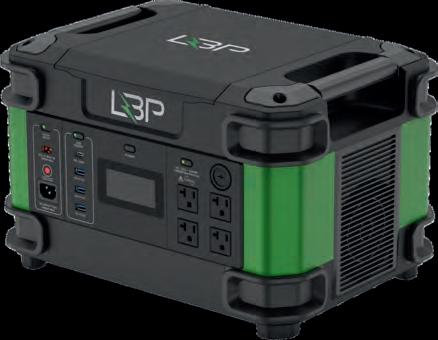




Lithium Battery Power (LBP), a leading innovator in advanced battery solutions, has taken top honors in the Energy category at the 2025 International Convention of Allied Sport!shing Trades (ICAST). e company’s groundbreaking Powerbox 2.5 kW / Solar Panel Lithium Battery Charging System was awarded the Best of Category: Energy, signaling a major leap forward in sustainable, high-performance energy technology for anglers and outdoor enthusiasts.
Held annually in Orlando, ICAST is recognized as the world’s largest sport!shing trade show and a hub for innovation within the industry. Each year, hundreds of new products are submitted for consideration across multiple categories, but only the most impressive make it to the winner’s circle. LBP’s Powerbox system stood out for its combination of portability, power, and green energy integration. e award-winning Powerbox 2.5 kW system delivers robust, reliable energy storage and output
in a compact, rugged form factor. It’s designed to meet the demanding needs of outdoor enthusiasts who rely on consistent power in o -grid environments. Integrated with a high-e ciency solar charging panel, the system ensures power sustainability even during extended trips, reducing the need for fuel-powered generators or frequent dock visits.


outages, hurricanes and critical jobsite power along with the heavy 12 volt demands in marine environments got their attention over all others in the Energy category.
“We are honored to receive this recognition at ICAST,” said Don Mitchell, Sales Director for Lithium Battery Power. “Our goal has always been to push the boundaries of battery technology while supporting eco-conscious outdoor recreation. e Powerbox system is a direct response to what today’s anglers need— power that lasts, in a package that’s smart, clean, and easy to use.”
e judges at ICAST praised the Powerbox for its innovative design, versatility, and emphasis on clean energy. Weekend power
is win marks a signi!cant milestone for Lithium Battery Power, reinforcing its position as a leader in the renewable energy sector within recreational vehicle and marine markets.
As the industry shi s toward more sustainable and e cient energy solutions, Lithium Battery Power’s win at ICAST 2025 signals that the future of on-the-water power is not just electric - it’s solar, smart, and built for adventure.

By Will Schmidt
If you have spent any time bottom !shing you know that occasionally on the heaviest of tackle you can outsmart a big snapper and end up with a solid !sh. Other days you can struggle to get even shorts. If you really want to up your game, it is time to lighten up.
When I say light, I mean straight 20 or 30lb mono and light wire 3/0 hooks. You may get broken o at times, but it is worth it for a box full of stud mangos and ARS. My go to big snapper setups is G Loomis IMX Pro Blues 843 casting rod with Shimano Trinadad TN20. is out!t is light, sensitive, and deadly on snapper. Some might like a bit lighter action rod but I have found that even with straight 20lb test you can really put a lot of pressure on these !sh and the backbone is nice to get them o the bottom as quickly as you can. A bit heaver is also nice when that grouper inevitably grabs the bait.
Here is a pro tip. One of the key elements for success to get big snapper, especially mangos, is the ability to react fast. Snapper get their name because they will o en quickly snap at a bait and then release it. With these sensitive rods and a gear ration of 6.2 to 1 you can pick up 46 inches of line in a single turn. A sensitive rod and a fast
reel means when you feel that tap, you can come tight instantly even in deep water. Remember you must use circle hooks so reeling vs setting the hook is the way to connect to these A fast reel might be the most important tool when snapper !shing.
My go to bait is a live pin!sh because, everything eats a pin!sh. I like having a livewell full of nice hand size pins. I do also use thread!ns both live and dead. read are great baits, but a good stout live 7 inch thread is remarkably strong and can be tough to get to the bottom as they swim o with your lead. at means dead threads can be easier to get to the strike zone. Cut the heads and tails o and make a thread “plug.” read “plugs” are awesome for snapper bait especially when live bait is not available. If hook ups are tough, I will double up my hooks, snelling 2 circle hooks close together and getting both hidden inside the plug to increase my hookup ratio. Regardless, I use 3 to 4 feet of mono leader then a swivel and a 3 ounce lead to hold the rig right on the bottom.

light and you will likely !nd the results are worth it.

Whether you really want to target big snapper or the bite is just really tough, try going
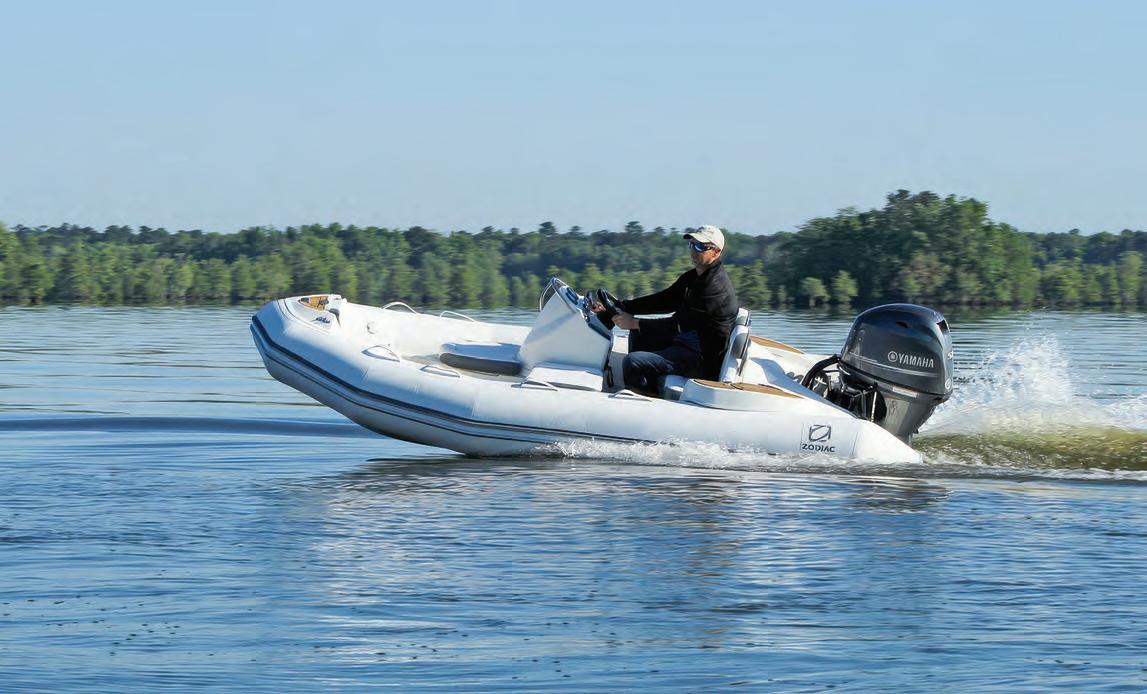




By A. deGruchy
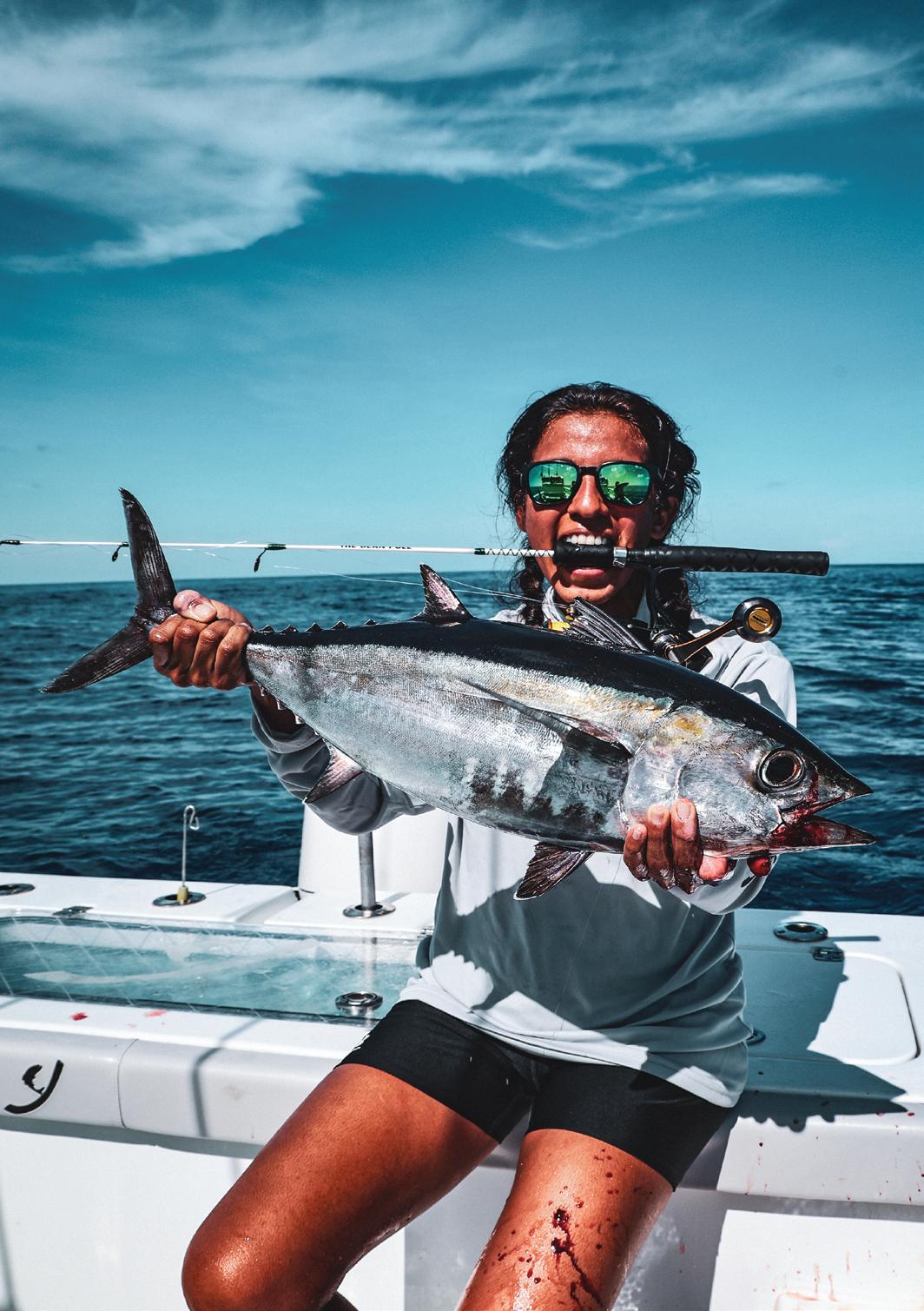
Late summer in the Florida Keys means steady black!n tuna action. Look for them around o shore humps like Marathon and Islamorada, especially early in the morning, and over wrecks in 200 to 600 feet of water.
Troll small feathers, ballyhoo, or bonito strips when the !sh are feeding near the surface. If they’re holding deeper, vertical jigging is the way to go. Savage Gear jigs in the 100 to 200 gram range work great. Drop them straight down and work them quickly to trigger bites.
For gear, the new Penn Spin!sher VII combo in the 4500 to 6500 size is a solid choice. Spool it with 30 to 50 pound braid and 30 pound uoro. It’s a strong and smooth setup that handles tuna with ease.
Watch for bird activity like frigates and terns diving. at usually means tuna are pushing bait to the surface. And always !sh with respect. Don’t troll behind another boat or crowd or someone who is already on a school. Give space and enjoy the bite.
Black!n tuna grade is better than blue!n in my opinion; you can eat it raw, do poke bowls, sushi rolls or sear it with sesame seeds!
Be sure to follow deGruchy’s adventures on YouTube (Bean Sport shing TV) and @bean_sport shing on Instagram.





RePower Packages designed to best ft your needs and not stretch your
Financing
Rest assured, all Mastry Suzuki RePowers are backed by Suzuki’s industry leading 5-year factory


Stationed strategically around the East Coast, all Suzuki RePower Centers have achieved the highest level of Suzuki certifcations to meet and exceed your repower needs.
Stationed strategically around the East Coast, all Suzuki RePower Centers have achieved the highest level of Suzuki certifcations to meet and exceed your repower needs.
When Considering A Repower, Consider These Factors:
•Every Authorized Mastry Suzuki RePower Center has decades of repower experience providing proper rigging, controls, propeller matching and in water testing
•With a Mastry Suzuki RePower, owners gain improved performance, less noise and greater reliability
•Mastry Suzuki RePower’s exclusive Owner’s Edge Program*
•Mastry Suzuki RePower Centers use authentic Suzuki OEM parts and have factory certifed technicians

Since 2014, Mastry Engine Center, has been building the premiere Suzuki Outboard repower network in Florida. Today, Authorized Mastry Suzuki Outboard Centers have been exceeding expectaions in the Southeast for over two decades. Recently Suzuki Marine requested Mastry Engine Center to expand the network throughout the Northeast. Now boat owners from Maine to Florida can be assured of the best support for their Suzuki outboard repower project. All Authorized Mastry Suzuki RePower Centers provide the best options, information and package pricing for excellent performance in repower.






*Get with the Program!
When you purchase a new Suzuki outboard from an authorized Mastry RePower Center you qualify to become a member of the Mastry Suzuki Owner’s Edge. Owners receive an identifcation card that provides them with important information about their Suzuki outboard motor as well as a passport to additional benefts during ownership. Members enjoy a detailed engine maintenance schedule, Mastry Suzuki RePower Trade Program and special pricing from Mastry Suzuki Partners

By Capt. Michael Okruhlik
When the end of summer is near and the tides align, there’s no place I’d rather be than Southwest Florida—with a rod in hand and visions of giant snook dancing in my head. !is year, my buddies and I made the pilgrimage with a simple mission: land a personal best. Big sh only. No compromises.


If I had to pick just one, hard twitch baits take the top spot. !ere’s something about that sharp, erratic dart through the water that drives trout wild — and the strikes are violent. Like “wake-up-your-neighbors”, violent. Twitch it, pause it, twitch again — boom! Bonus: many of these lures rattle, which adds an extra layer of appeal in the slightly stained surf water.
When I want a front-row seat to the chaos, I tie on a topwater. Watching a speckled trout explode on a surface lure in the calm surf is pure adrenaline. If it misses, keep working it. Trout in the surf are red up and aggressive — they’ll o en come back for seconds (or thirds). Like the twitch baits, these lures rattle too, which helps draw sh in from a distance.
!e silver spoon has earned its place in Texas shing history, and for good
reason — it still at-out works. I prefer a steady retrieve style spoon for consistent action over a jigging one, but that’s just personal taste. And hey, I’m a paddle-tail guy at heart, so a steady retrieve comes naturally.
So plastics shine in the surf, but go for durability. !ese sh aren’t sitting around like they do in the bay — they’re moving, and fast. !e last thing you want is to waste time swapping lures er every catch.
I use paddle tails with built-in tail rattles and super-loud rattling shrimp. Yes, rattling shrimp exist — and when trout are keyed in on shrimp, nothing else will do. !e realism and noise can turn a slow day into a urry of action.
Live shrimp under a rattling popping cork? !at’s trout candy. It’s simple, e ective, and deadly on calm days.
But if the bite gets nicky, break out the big guns: live croaker. Controversial? Sure. E ective? Absolutely. When the water’s crystal clear and the trout are being picky, croaker can be a day-saver.
Don’t be surprised if a slot red — or even an oversized bruiser — crashes the party. Every lure and bait on this list will get crushed by reds in the surf. Be ready. !e surf might be calm, but your drag won’t be.
Calm surf days are perfect for family shing. Easy wading, plenty of action, and good-sized sh make it a blast for kids and adults alike.
One nal tip: if there’s any southwest wind at all, do what the surfers do on at days — stay in bed. It’ll save you some frustration.
So check that forecast, grab your favorite rattling lure, and remember: always take a kid shing.
Capt. Michael Okruhlik is the inventor of Knockin Tail Lures®, and the owner of www.MyCoastOutdoors.com.






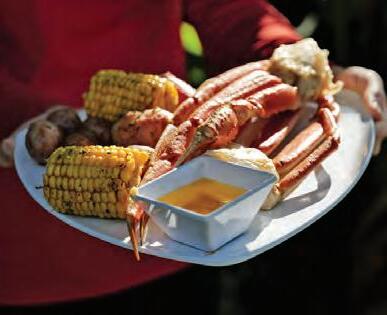

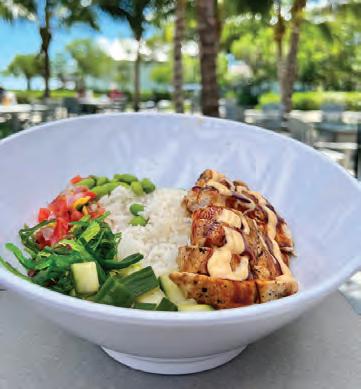



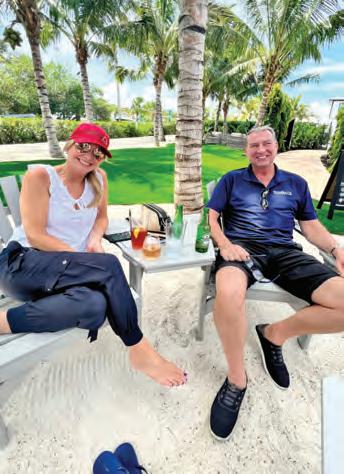

DARLENE TAYLOR
JERRY TAYLOR

If you love the outdoors and dream of being in business for yourself, now is the perfect time to choose a Coastal Angler or The Angler Magazine Franchise.


Capt. Glyn Austin
Capt. Lukas Brickweg
Capt. Chris Cameron
Capt. Scott Goodwin Charlie McCullough
Capt. Troy Perez
Capt. Jim Ross
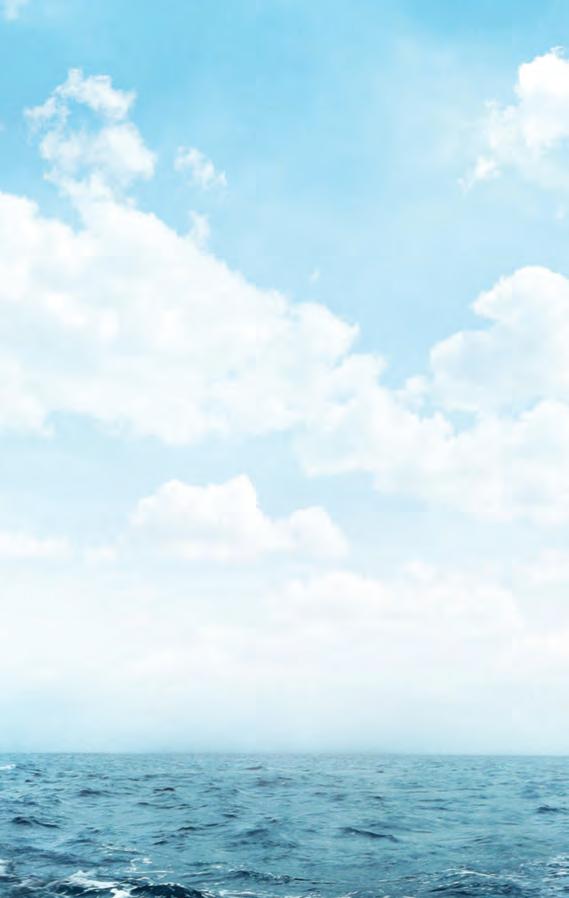






September is the start of snook season. Try fishing in the surf and along the jetties at local inlets. The “Mullet Run” usually gets started by mid-September or early October, depending on tropical storms. You will see the mullet exploding in those areas and along the beaches. Tarpon, jacks, bluefish, Spanish mackerel and sharks will be feeding on the mullet schools so there can be a lot of action. Use a cast net to catch finger mullet as bait. I use a 15-20 lb. braid tied to a 30- 40 lb. fluorocarbon leader with a 3/0 J hook. If the tarpon are big and the sharks are around, use wire on the sharks and heavier rods with 2030 lb. braid and 60 lb. leader and up-size to a 7/0 circle hook. Try adding a 1/2 ounce slip sinker or split shot to your mullet to have a better chance to catch a flounder or redfish. Free lining mullet will also produce bites. Also, tripletail fishing will pick up with the change in the weather, especially after we get a few of the season’s northeast blows.
The redfish, trout, black drum, etc. bite will heat up in September because of the finger mullet run, change of weather and shorter days. When the water is high from summertime storms, fish the Indian River and the Mosquito Lagoon closer to the shoreline. Try fishing underneath the mangroves; you never know what you will catch when the water is high. This is one of the best times of year to use artificials. Use a light 1/16 or 1/8 oz. jig head with a paddletail, or a soft-plastic jerk bait. I use 8-10 lb. braid with tied to a 25 lb. fluorocarbon leader when using artificials. After

rains, find drainage ditches or where culvert pipes are dumping into the river. If you prefer using bait, use live shrimp, finger mullet or cut bait. Fish points of land and drainage pipes where the wind is blowing onto it. The drainage pipes will often have smaller tarpon and snook around them. Fly fishing small flies and small jigs, like mini jigs work best for small tarpon and snook.
The day after heavy rains and strong winds can be the best day to fish. I catch the most snook in September in the river due to the water levels

being up and flowing to push the snook out from the mangroves and out of the marshes where they like to hide.
Troy’s Tip of the Month: Fish after a hard rain.
CAPT. TROY PEREZ
Troy Perez Fishing facebook.com/captaintroyfl capt.troyperez@gmail.com (321) 607-2033


Tired of worrying about your cell phone slipping, falling, or getting damaged while you’re out on the water?
Hold Fast Pro provides the must-have boat accessory that gives you exactly what you need—a STRONG HOLD and FAST ACCESS to your cell phone.

Built to handle the water, salt, and sun, our adjustable boat phone holder boasts a secure design, versatile features, universal fit, and the ultimate in durability and convenience.


The “Dog Days of Summer” seem like an understatement as we endure extreme heat waves and limited rainfall. The rivers are regularly hitting 90-degrees and showing signs of algae blooms, however good fishing can still be found when conditions align with cleaner water and bait.
Pete Black of Marker 24 Marina recently had an epic morning throwing topwater lures along the edges of the mangrove shorelines. He commented, “ I’ve fished several mornings throwing my skitterwalk and had some really good fishing. One morning, the lure just kept getting crushed by nice snook and redfish. The key seems to be fishing early! It has been best in the first glow of morning. Once the sun gets bright, it’s over.”
So, focus on morning and evening windows when the fish and fishermen can beat the heat!





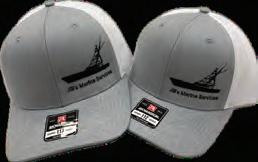




Summer is winding down here in Central Florida; not so much the heat as the free time. Kids and teachers headed back to school last month, the daylight is slowly shrinking in duration and we will all be anxious for summer to return. Luckily, we don’t shut down our outside activities like other locations and we get to use our boats year-round. But taking a break from all the fun to do maintenance on engines and systems is very important to continuing our year long adventures.
Here at Marker 24 Marina, we spend a lot of time doing boat maintenance, both on our own boats and for our customers. We thought we would put together a list of common maintenance items and habits that will keep your boat in top condition and ready to go.
1. Always use non-ethanol fuel. We sell rec-90 which has no ethanol added and has 90 octane. We also offer marine diesel fuel. Fuel/ Water separator filters should also be changed or checked for accumulating water.
2. Always flush your engines as quickly as possible after use in saltwater. Outboards and inboards alike need flushing to prevent corrosive saltwater from sitting in metal passages. We can add flush kits to inboards for customers to make this chore easier.
3. Wax your hull and protect other surfaces like vinyl, rubber and metal. We carry a wide variety of boat maintenance products as well as offering full boat detailing as part of our boat yard services.
4. Maintain, charge and monitor your boat’s batteries. A boat cannot just sit for a year without charging or checking systems. A boat can sink on land from rainwater if the batteries run down and the plug is in. A trickle charger on a timer is my go to if conditions allow.
5. Check your float switches or automatic bilge pumps. Unfortunately this important component often goes bad and needs to be checked or replaced. A float switch should be wired into a 24/7 power source with a fuse and not through the normal electrical channel that is disabled with the battery switch.
6. Turn off switches and breakers. Speaking of battery switches, you should always get in the habit of turning off the battery switch and trolling motor breakers as you leave your boat. The only power left on should be the float switches to your pumps. This is to prevent fire from a short in a system and to preserve the charge for your next trip.
7. Protect your boat from the sun. Sun protection is so important, but especially in Florida
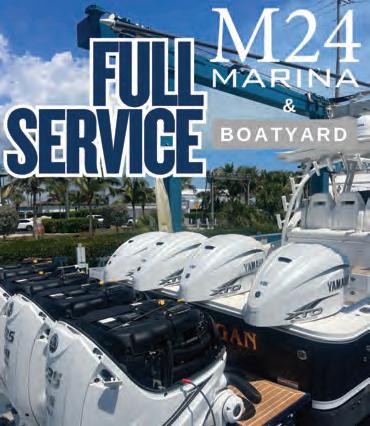
where boats take a beating from the elements. Covers or boat houses are crucial to maintaining the finishes of your boat (as well as regular waxing).
8. Survey the scene. As you walk away from your boat after a day of good fun, stop and look back. Run through your mental checklist and just survey the scene looking for things you forgot to do. Those few moments of concentration have saved the day many times.
Marker 24 Marina is located on the Banana River at 1357 S. Banana River Dr., Merritt Island, FL 32952. Contact them at (321) 453-7888, marker24marina@gmail.com, or visit marker24marina.com.

*Limited Time Offer—Call Today!
Marker 24 Marina’s staff of trained experts specializes in helping boaters like you continue to make lasting memories on the water. From the controls and rigging to additional technologies and post-purchase support, we’ll help you every step of the way. Take advantage of our affordable services and enjoy increased performance, reliability and peace of mind on the water.




IT’S TIME!!!!!! That’s right—it is time for the start of the Fall Mullet Run along the Space Coast. Just about every species of coastal saltwater sport fish will be available for anglers fishing outside of the Port Canaveral basins this month.
Snook season opens on the first of September, so all of those giant snook my charter clients have been catching all summer long now have the potential to be invited home for dinner—if they fit within the slot limit. Tarpon, king mackerel and sharks are some of the other apex predators that can be counted on this month. Each of these species will strike live mullet in and around the pods migrating south along the beaches in the daytime. During dawn and dusk periods these fish will strike lures that imitate the mullet as well. The Rapala X-Rap 12 is one of my go-to lures; the other is the Saltwater Assassin Artemis Shad in the silver mullet or pilchard colors.

This month and next month are unquestionably the best two months of the year to get out and go catching, so give me a shout and let’s go catch your next memory!

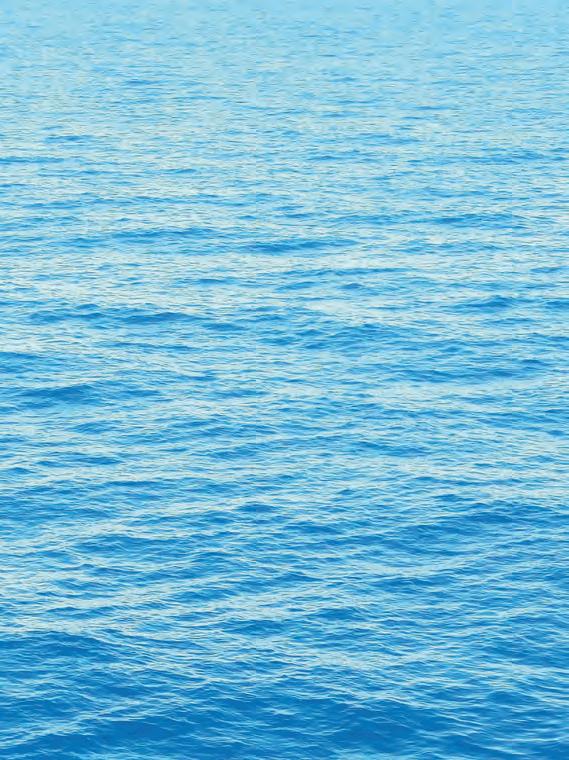















What a great month of fishing we had in August! Gotta love it...
The bunker have been easier by the day to get. They have been in the Port and fairly easy to net for a change. Some days in the bight, some days the steeple, but it’s around. Here’s the kicker, now that you’ve got the prime choice in bait, your targets don’t want it and want frozen. Yup. That’s right. So here’s the lesson, try both— one dead and one live—and see what gets hit on better. We couldn’t figure out what the deal was with the live bait after marking fish until we tried the switch up. Who would’ve thought? Also, don’t forget about the cans. They have been holding sardines, and a sardine will always get hit.
Mixed in the kings have been cobia and still some lingering mahi. Pretty crazy to have such a consistent pick of mahi this year. For the cobia, keep the jig ready in case that brown one swims up behind the boat.
This is a great month for wreck fishing. Use all your normal tactics, from three ways to knocker rigs. Live bait definitely works the best. Use lighter tackle for more fun. Amberjack and every other species have been sitting right above the wrecks and it’s been great.
You can also try anchoring and chumming. Use some lighter fluorocarbon for the mangos. They have been plentiful! Even the muttons have been surfacing.
Don’t forget about chicken rigging all the


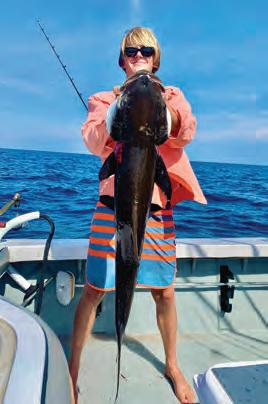


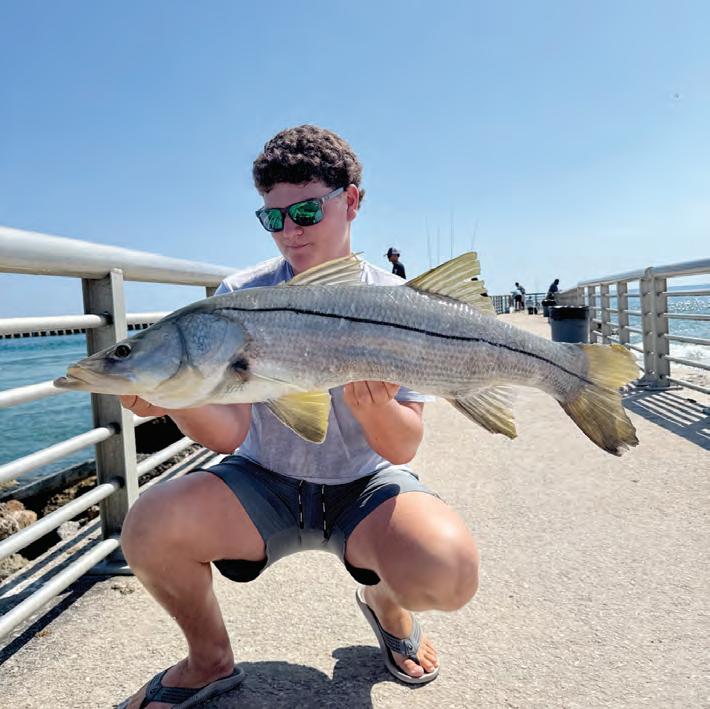
Jordan Rapp (@thatboyjr_08) says he’s been hitting the snook day and night off Sebastian Inlet. He caught this 35-inch one off the pier with a flair hawk jig.

with his buddies
definitely

Matt Vigliotti caught this 29.5-inch, 22.8 lb. tripletail in the Indian River using a live pilchard and marker.


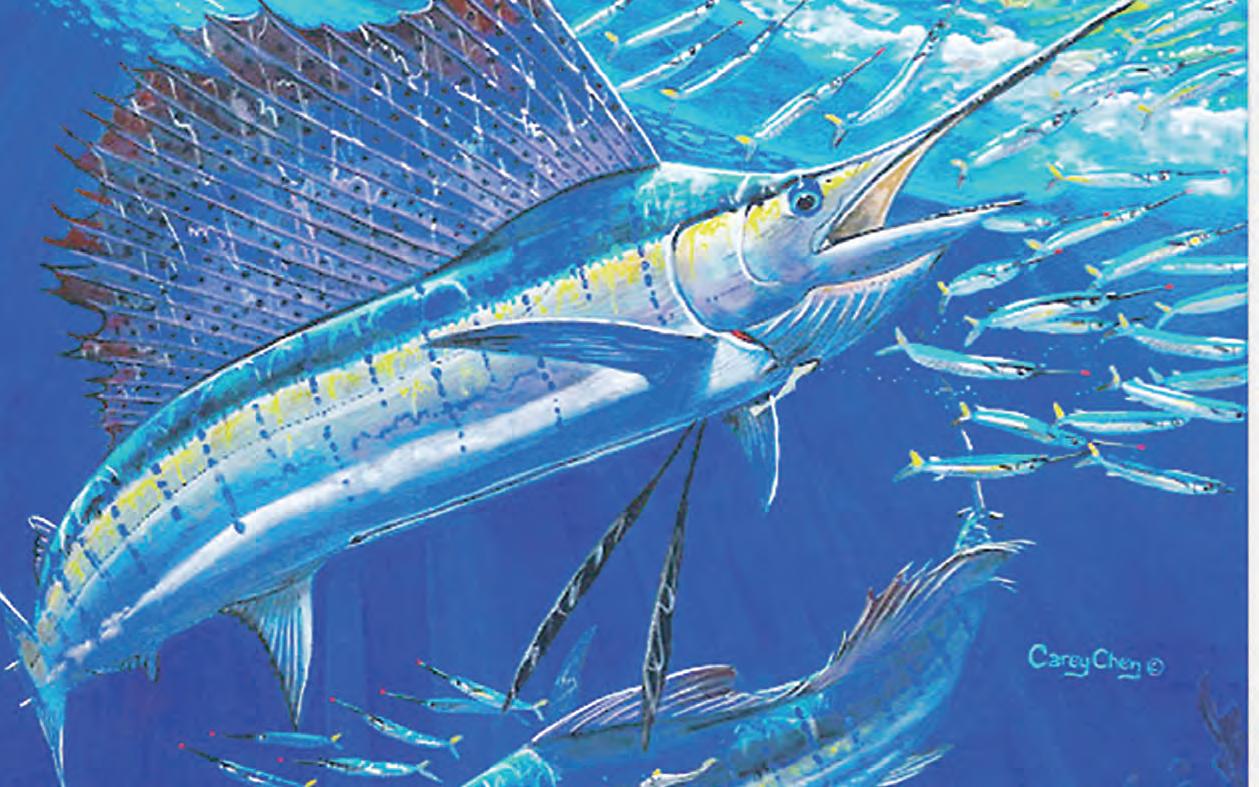




Jason Young was trolling a naked ballyhoo in 150 feet for only 10 minutes when this beautiful 21 lb. mahi hit. After a 10 minute fight it was in the cooler!

Little 7-year-old Gracelyn did some after school fishing with her dad, Capt. Shane Trottier, and landed this nice 29-inch keeper snook.


KJ reeled in a nice little 12-inch snook at Haulover Canal on his first cast of the day. He was stoked!
Track Tucker shows off his new personal best largemouth bass he caught with a watermelon wacky rig.
Colton Brown with his first redfish, caught with a live mullet on the outgoing tide right at the mouth of a creek. It was 23 inches. GET YOUR BRAGGIN’ ON! Upload your high-quality photos (at least 1MB) with

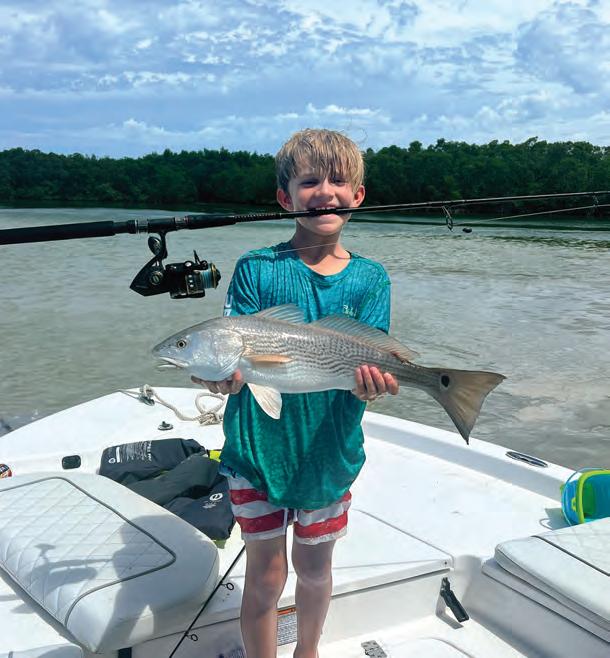




September is one of the best months to target snook on the Space Coast. They can be caught on the beaches, at the inlet, and in the lagoon. Assuming we get a decent mullet run, the snook should be fired up and found feeding on many of the mullet schools migrating south.
Locating the mullet is crucial, and staying with them is the key. These schools can sometimes move very quickly, and if you don’t stay with them, you’re effectively in no man’s land, so be prepared to be mobile. This makes live bait fishing more difficult in these situations, so throwing artificials proves to be a great tactic for the fast-moving schools. I usually opt for the Hogy 2 oz. paddletails in the mullet color pattern during these times. Work the edge of the schools with a steady retrieve and keep that same retrieve all the way to the shoreline, as oftentimes the snook will eat extremely close to the beach. If anything, reel faster than slow with your steady retrieve; often, that will generate a reaction strike. As for leader, 40 lb. mono or flouro is generally what I’m throwing for snook in these scenarios. For live bait, net or snag mullet, and use a good quality circle hook like the Owner Mutu Light. For finger mullet, go with a 3/0 size; for larger mullet, opt for a 5/0 to 7/0. Using a good surf rod in the 9’ to 10’6” range is
what I’d recommend for most days, but a smaller rod can work well if the mullet are in really close. My usual beach setup for targeting snook is a 9’ Star VPR paired with a Shimano Twin Power 5000 spooled with 20 lb. braid. This setup is light, casts well, and has plenty of power to quickly land the biggest of snook.
The snook
fishing in the IRL can be epic in September. As with the beaches, the key is to fish around the mullet schools, and you’ll be in the game. With how hot it is, we can expect the fish to be in areas with shade and deeper water often. If you see a school of mullet headed for an area like that, that’s the best scenario to fish. A great tactic is to use live mullet as the fish are keyed in on them, and they’re readily available to cast net. Artificials can be used with success as well. Paddletails/soft plastics work well, and topwater lures work great early morning.
My setup for fishing the lagoon is a 7’ medium heavy rod paired with a 5000 reel spooled with 20 lb. braid and tied onto a 40 lb. leader. I use circle hooks exclusively to protect the fish from being gut hooked, as we release the majority of the snook we catch.

By Ryan Caravello
If you’re lucky enough to be at the inlet when a school of mullet comes through and the snook zero in on them, you’re in for an epic bite! I like to rig my mullet on a long 40 lb. leader and with a small split shot to get them under the school and slowed down. Depending on where you are in the inlet, the tactics change, but when it’s hot, it’s hot. A good bet if you’re fishing from land is right in the jetty pocket on the beach side during the mullet run. Here you can throw artificials and live mullet with success and it can be spectacular!
Good luck, and have fun!
Ryan Caravello has spent countless hours stalking the Indian River Lagoon and Brevard’s beaches, targeting snook and tarpon, and has made a name for himself doing it. Ryan has passionately shared this experience with his wife and two daughters, and cites the memories of catching snook with his family as his most cherished. If you’re one of the many who have wanted to fish with Ryan, your chance is coming soon as he’s offering guided trips aboard his 26 Andros starting this fall. Instagram: @rcaravello.



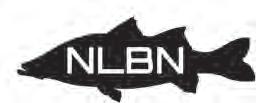




September is one of my favorite months to fish on the Space Coast from Melbourne to Sebastian. The bait is plentiful and the snook, trout and redfish are as well. Although redfish are closed to harvest, if you want to target them for catch and release, this is one of the best months of the year to do so.
With snook season starting up again on September 1st, anglers will be out in droves trying to get their keeper fish. Most southern Brevard County anglers will gravitate to the inlet, however, our entire area— from Melbourne to Palm Bay and Sebastian—is a great place to catch snook as well as redfish, tarpon and big jack crevalle in the lagoon in September.
And September isn’t only the start to snook season; it’s also the start of the mullet run a little later in the month. There will be schools of mullet along the beach as well as schools of threadfins and sardines. Tarpon, snook, sharks, jack crevalle and kingfish will be following the schools of bait looking for that easy meal. Best bet is to use some of that live bait and fish the outer edges of the bait pods. The Rapala X-Rap Long Cast in size 14 will be an excellent hard bait to use when targeting the bait pods. I also like to use Rapala’s Crush City Jerk baits as well as D.O.A. Baitbusters during the mullet run along the beaches. All of the above lures use single
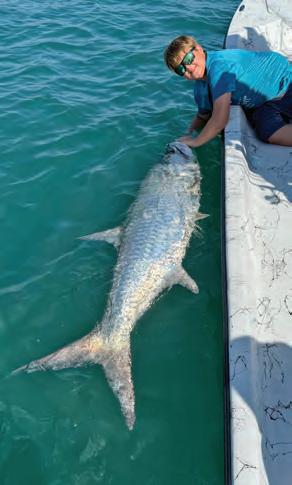

hooks instead of trebles which are better for the fish that you have to release and safer for the angler.
The mullet should also pour in the creeks from Melbourne down to Sebastian and the gamefish are sure to follow. No need to go way back in the creeks; anglers can fish the mouth of the creeks and around the many oyster bars and docks closer to the Indian River Lagoon. I use the same baits in the creeks as I use in the lagoon during the bait run.
If the beach is too rough, focus on the flats, spoil islands or mangrove shorelines loaded with bait in the Indian River Lagoon from Melbourne to Sebastian in late September. My favorite bait to use is the Rapala Skitter Walk topwater, and their Twitchin’ Minnow and Twitchin’ Mullet are great subsurface baits for fishing the mullet run. If soft baits are your preference, try Rapala’s Crush City Mooch Minnow or D.O.A. C.A.L. 4” jerkbaits in the
The 3” CAL Shad Tail
GLYN AUSTIN
(321) 863-8085




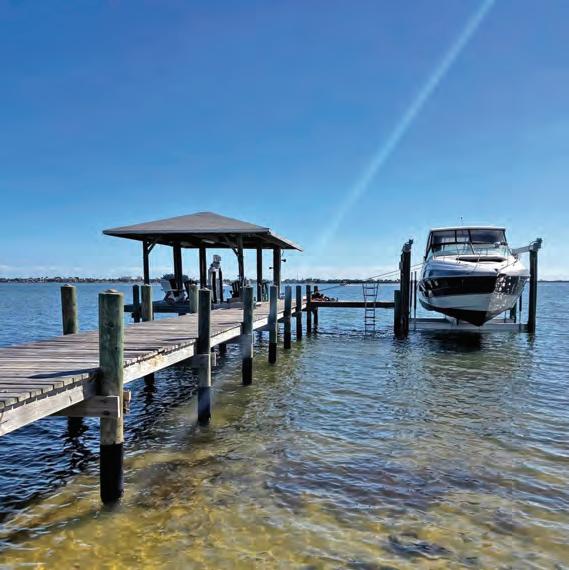


Ben Martin Editor in Chief Coastal Angler Magazine “ ”
Maguire’s first work is a compelling, fast read. His style is like a mix of Hemingway with a sardonic blend of Hunter S. Thompson. I couldn’t put it down...

Confessions of a Fishaholic, by Thatch Maguire, is a hilarious and irreverent look at one man’s quest to catch fish in spite of life’s annoying interferences. You’ll travel with this awkward adventurer as he risks home and health to pursue his passion for fishing...regardless of the consequences. Anglers of all expertise levels will immediately identify with why his addiction is incurable. This book defines the blurred line between passion and obsession.



Temperature relief needed! But cooler weather is just around the corner. Get ready for the upcoming Central Florida Shad and Crappie Derby! Crappie season begins in September then American shad will soon follow, typically around Christmastime.
Largemouth bass, sunshine bass (striped), and black crappie will be the targets for September. Look for schooling bass early mornings at the mouth of the river on both sides of Monroe and Harney. Bass anglers are having luck with lipless crank baits, shallow running slash baits and topwater plugs. Devil’s Horse lures thrown right at the shoreline are working, so are swim baits along weeds next to drop-offs. Stripers will readily hit topwater lures in the same areas you find bass in the river.
Speckled perch (crappie) season begins in September with the first spawn typically occurring in the second half of the month. Large specks can be caught when they stage up in the 6- to 8-foot depths while males are prepping the beds. Longline trolling with a minnow-tipped 1/8-ounce jig (use your favorite-colored tail) at about 1.2 mph should do the trick. Vertical slow-trolling, known as spider-rigging, will also tempt the big ones and speeds may vary between .4 and 1 mph. Make sure your weights correspond to trolling speed, keeping your lure in the strike zone. Faster equals heavier egg sinkers; use 1/2, 3/4, and 1-ounce sizes. Jigging the pilings of the 417 bridge over Lake Harney is good early season. Recommended crappie baits: minnow-tipped Road Runner lures, Mylar jigs, and Johnson spoons for shad. Don’t forget—always tip your jigs with a minnow to get more bites.
Never forget your sunscreen and SPF clothing in Florida. Gloves made by Glacier Outdoor are a great way to protect hands from sun (and fish hooks too). And take a kid fishing—you’ll make forever memories!


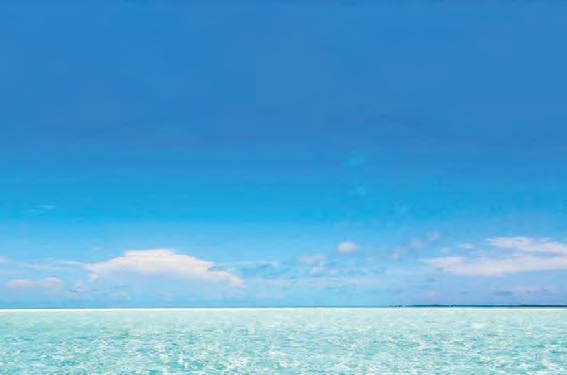



Operating in Oviedo, Florida for almost three decades, and in the rod building and tackle business for almost 50 years, Mud Hole is Central Florida’s Premier Full-Service Tackle Center. While they have focused primarily on custom rod building and tackle crafting over the majority of that time, Mud Hole recently relaunched their impressive Oviedo showroom with an amazing array of fishing gear and tackle.
Whether you’re targeting reds in the Indian River Lagoon, going offshore for big snapper, or hitting Headwaters for lunker largemouth, Mud Hole carries the rods, reels, lines, lures, tackle, and apparel for all of Florida’s favorite fisheries. They have a wide selection of your favorite brands, including Shimano, Daiwa, AFTCO, NLBN, FREE FLY, Marsh Wear, 6th Sense, Gambler Lures, Z-Man, Buzbe, Zoom, Yamamoto, and so many more! Mud Hole even offers boat accessories and line spooling – so you

can hit the water ready to fish!
Mud Hole is also the world leader in custom rod building. So, if you want to learn a new craft, Mud Hole offers professional rod building classes in their Oviedo Rod Building Education Center. Plus, they carry all the tools, equipment, and supplies you need to build your own custom rods. They even have rod building kits that make it easy for beginners to get started in this rewarding hobby. Hook, line, and sinker, Mud Hole has everything you need to outfit your next fishing
One of best times of year to catch snook in the surf! September and October hold the combination title with the peak of the mullet run along the Space Coast. Throughout East Central Florida, mullet and other baitfish will be pouring down the beaches. With that being said, the predatory fish including snook and tarpon will be acrobatically attacking this once-a-year phenomenon. Depending on the annual waves of migratory mullet, each week will hold alternating peaks of heightened fish activity. The preferred method for targeting snook in the surf will be a gorilla style surf fishing approach: armed with a single casting rod in the 7- to 8-foot range and reel sizes in the 4000 to 5000 series. This light and mobile attack leads to a strategy that gives the angler freedom to move along the shores with ease. Cocoa Beach Surf Fishing Charters employs this method with our clients to catch snook, jack and tarpon while actively fishing for pompano and whiting.
Swim baits, jigs, plugs and live bait are the preferred choice when rigging your light tackle casting rods. Oftentimes, I will begin my search for targeted areas by approaching several beaches and looking for crashing birds, exploding baitfish or surging snook crashing the shores. One of the beauties of this specific fishery is the fact it can be so visual with the sight of aerialist snook and tarpon leaping from the water. This sight can be easily depicted, making for a focused attack easier to come by. Shark fishing charters will be a big hit this time of year, too, as the heightened activity creates opportunity for feeding sharks.
Not only will the snook and tarpon be in full swing, but we also start to see pompano pushing into Brevard County waters. The real pompano activity doesn’t start to heat up until November, but some of the first schools may appear on northern beaches. Pompano rigs with clam and crab flavored Fishbites tipped with fresh shrimp or sandfleas will hold success for most catches. CAPT. LUKAS BRICKWEG
(321) 205-4672

adventure. Make sure to stop by and see what all the excitement is about. And if you’re out-of-town, check out Mud Hole online at MudHole.com for the same amazing selection!

2133 Component Loop, Suite 1001 Oviedo, FL 32765 866-790-7637 • MUDHOLE.COM







It’s no fsh tale when you run with a John Deere. You can get everything done faster and easier, so you get more time on the water. Plus, our special offers make them the catch of the day.



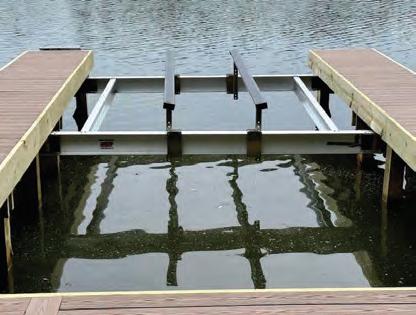




ShoreStation hydraulic boat lifts are a reliable choice for coastal residents and boating enthusiasts alike. Their strong construction, made with corrosion-resistant materials, allows them to withstand harsh environmental conditions, including sun, storms, and saltwater damage. ShoreStation provides a steadfast solution for protecting waterfront investments, o ering peace of mind to owners in the Sunshine State.
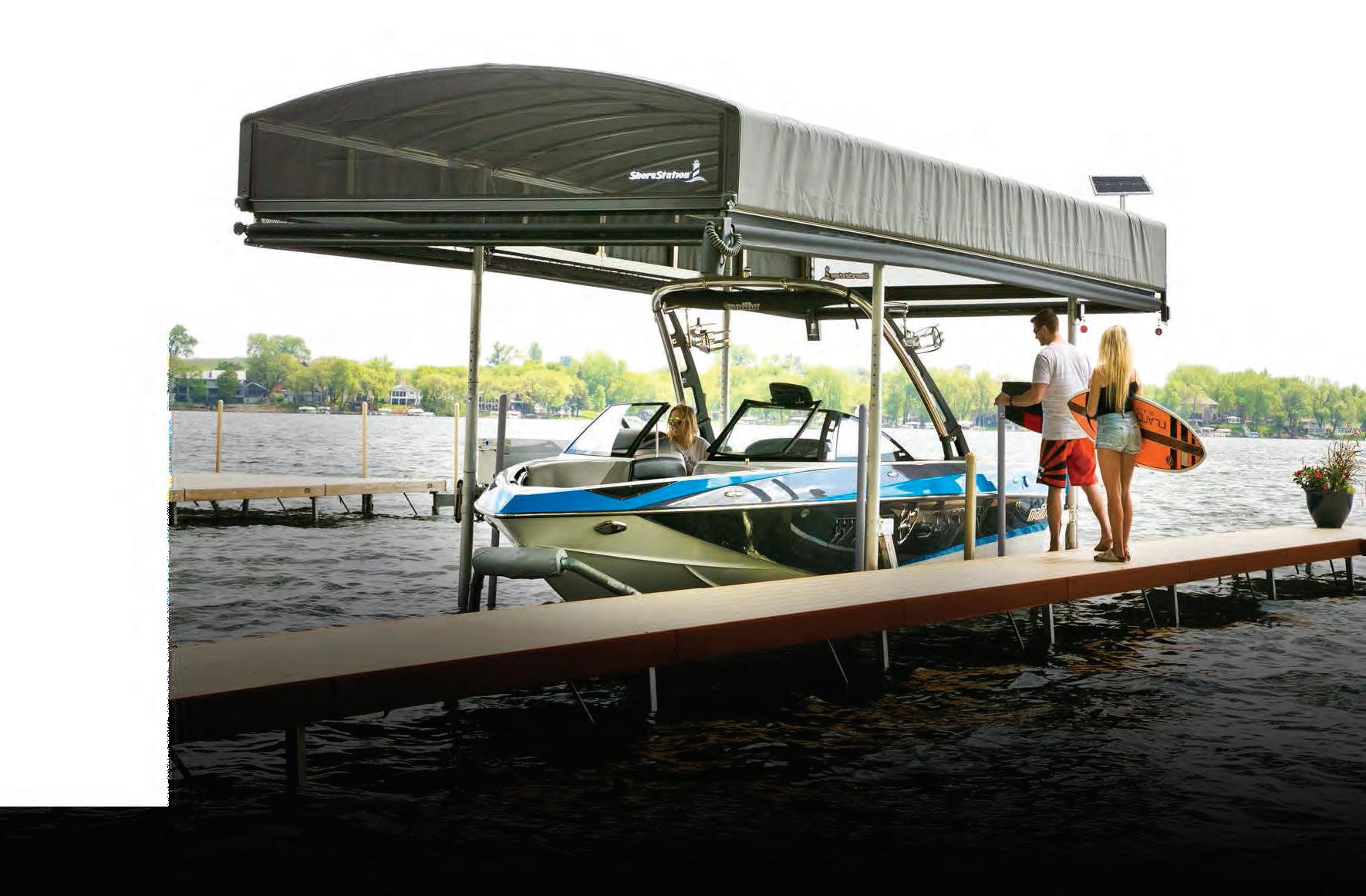






Equipped with exceptional weather resistant fabric and breathable SunTex 80 woven mesh ends for maximum protection and durability,

Made from the highest quality materials, our innovative hydraulic boat lift is one of the fastest and safest lifts on the market today. When you have a hydraulic lift, there’s no need to worry about wind and waves getting in your way. This lift will give you con dence to safely land and secure your boat in less-than-ideal conditions.
Never miss another moment on the water. Power your lift with clean, free solar power. Our speedy 20 watt charger features solar regulator drainage protection, saving your battery from permanent damage caused by overcharging.



























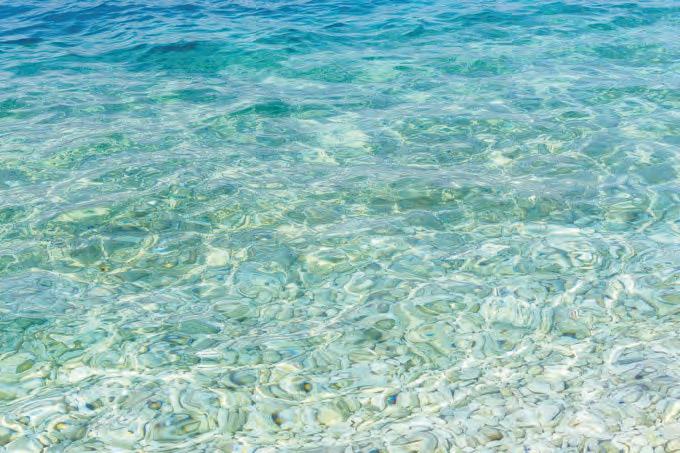





An angler from the Midwest recently had a !shing experience to remember along the banks of the Missouri River near St. Louis.
Wally Klein hooked an enormous 86.8-pound blue cat!sh—an incredible catch that tested both his !shing technique and physical strength.

Using gizzard shad as bait and a standard rod-and-reel setup, Klein fought the powerful !sh before !nally bringing it ashore near Washington, Missouri, according to the Missouri Department of Conservation (MDC).
A er snapping a quick photo to commemorate his achievement, Klein released the massive cat!sh back into the river unharmed.

Klein told MDC o cials it was the largest !sh he’s ever caught. e department congratulated him on the impressive feat, saying, “Congrats on this impressive !sh.”
e Missouri River is a well-known destination for trophy cat!sh, particularly blue cat!sh, which are prized for their size and their spirited !ghts—making them a favorite and true challenge among seasoned anglers.
Klein’s cat!sh was a monster, but it didn’t quite break the state record — which was also set in the Missouri River. Back in 2010, Greg Bernal landed a 130-pound blue cat!sh, a catch that was a world record at the time.
Want to learn more about cat shing Missouri’s big rivers?
Visit: https://mdc.mo.gov/ shing/species/cat sh/big-river-cat shing.



Capt. Mike Smith

The common snook, a.k.a. linesider, a.k.a. robalo, is one of the most sought a er game!sh in Florida waters. Sportsmen and women from all over the world come to Florida to catch these hard !ghting, jumping, head shaking, drag pulling !sh.
Snook will de!nitely eat top water lures, jigs, jerkbaits, wake baits, suspending hard baits, spoons, and ies but they love arti!cial shrimp.
Arti!cial shrimp will catch snook all year long; day or night; salt or fresh water; in every ecosystem, anywhere that snook live.
One of the best ways to catch snook with arti!cial shrimp is skipping them under and around structures like mangrove branches, docks, sea walls, sand bars and oyster bars. Pitch the shrimp to the structure and let it sink. en give it a twitch, twitch and let it sink again, then twitch, twitch and repeat the process until your arms get tired of reeling in linesiders..
Snook like a slower retrieve in the cooler months. Make sure to slow it down when the water temperatures approach the 70 degree level or less. A faster retrieve works better when water temperatures are between 75 and 85 degrees. Snook o en stop biting when water temperatures get above 90 degrees.
Another great characteristic of the arti!cial shrimp is that it skips like a dream. e 3 inch shrimp is the go to arti!cial shrimp lure for most hardcore snook !shermen. However, there are days when the snook are more discerning and a 2.75 inch or a larger 4 inch shrimp is the better size and pro!le choice.
e best color choices for shrimp lures are transparent, natural colors with gold or silver glitter in them for sunny days and clear water scenarios. More opaque and darker colors work better in dirty water and on cloudy days.


Many !shermen struggle when !shing arti!cial lures into tight cover scenarios. Sometimes, it takes about 50 casts and the loss of a half dozen shrimp lures to perfect the technique. But it is de!nitely a skill that any serious snook !sherman needs to master.
Capt. Mike Smith, owner of Fish Your Ass O Charters, is an inshore shing guide who has been shing the inshore waters, oyster bars and grass ats of Florida for more than 40 years. Reach him at (561) 339-2317, email: contact@ shyourasso .com or visit shyourasso .com.








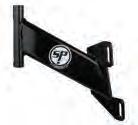














Whether for sport or for the table, pan!sh—especially slab crappies and hand-sized bull bluegills—are a favorite target among anglers. And when the air cools and leaves start to fall, pan!sh !shing heats up. Autumn can be one of the best times to catch these !sh, but it comes with a unique set of challenges. Changing vegetation, dropping water temperatures, lake turnover, and bait!sh migrations can make !nding pan!sh feel like solving a seasonal puzzle.
Fortunately, by learning to read these fall cues you’ll consistently !nd success on the water.
As lake temperatures cool and turnover occurs, bait!sh begin shi ing toward shallower cover where they can !nd safety and warmth. is movement sets o a chain reaction. Pan!sh follow the food, o en stacking up around cover like submerged wood or rocky structure. ese areas become prime real estate for fall !shing.
Weather plays a major role, too. On cold, blustery fall days, pan!sh o en slide deeper, becoming more predictable and easier to !nd with electronics. Deep basin areas in 20 to 25 feet of water can light up with schools of crappies—and sometimes bluegills—suspended and ready to bite. ese deeper !sh are o en aggressive, making for a rewarding but ethically sensitive bite. When !shing at those depths, barotrauma becomes a real issue. Released !sh o en don’t survive, even if they swim o , so it’s important to harvest what you catch, regardless of size.
On the ip side, when the weather is mild and
the sun is out, pan!sh can be found shallower, relating to weedlines, cribs, and brush piles. Healthy, vertical weeds are a magnet for fall pan!sh and can hold !sh all the way into !rst ice. In fact, some of the best fall bluegill bites happen in just !ve to eight feet of water, especially in lakes where dense, green weedbeds persist.
Lake size also in uences fall behavior. On smaller lakes—200 acres or less—dropping water temps and decaying weeds tend to concentrate !sh even more. As long as green weeds remain, pan!sh will hold tight to them. But as those weeds die o , the !sh begin to push toward deeper structure or out into the basins in preparation for winter.
Crappies in particular become more predictable in the fall, o en schooling up tighter and acting more aggressively than during other seasons. ey’re easier to pattern as they transition from summer haunts to winter basins, o en stopping along the way at deep weedlines or submerged timber. In lakes with ample wood or crib structure, these can be hotspots that hold large schools well into late fall.
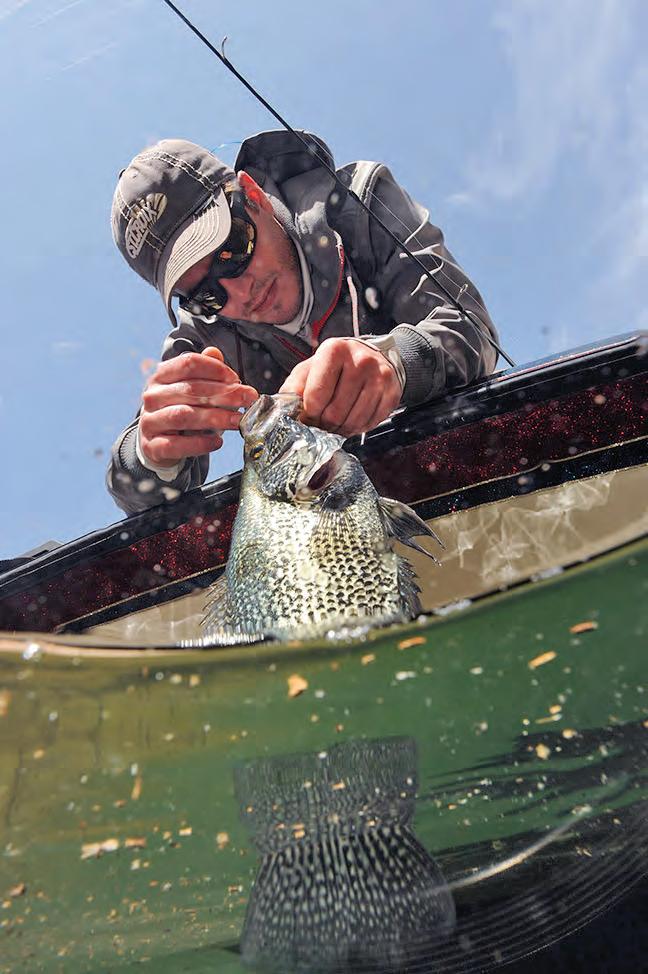
Bluegills, while more opportunistic and scattered, still relate strongly to weed edges and shallow cover when the conditions are right. eir adaptability means they can be caught both shallow and deep, but they may take more searching to !nd than their crappie counterparts.
Despite the variables, the recipe for fall pan!sh
success remains relatively consistent: follow the forage, !nd healthy weeds or cover, and adjust based on the weather. Whether you’re chasing aggressive schools of crappies in deep water or hunting bluegills in shallow weed patches, fall o ers a window of opportunity that savvy anglers won’t want to miss.





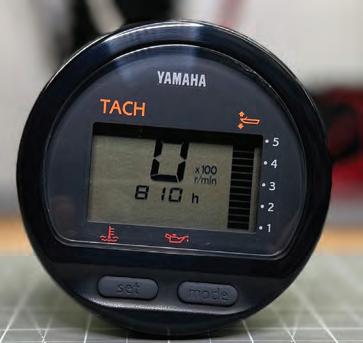




Nestled in the heart of the Caribbean, the US Virgin Islands embody a harmonious blend of natural beauty, cultural vibrancy, and laid-back serenity. ese islands are more than just a picturesque getaway; they are a living testament to nature’s rhythm and resilience, e ortlessly in tune with the world around them.
With no passport required for U.S. citizens, from the moment you arrive, the islands’ natural rhythm is palpable. e gentle sway of palm trees, the soothing sound of surf crashing against sandy shores, and the vibrant melodies of local music all echo the heartbeat of this tropical paradise. e islands’ lush landscapes, with their verdant hills and crystal-clear waters, mirror the steady pulse of life that sustains the local ecosystems and communities alike.
e US Virgin Islands’ environment is a symphony of biodiversity with world class !shing and diving. ese natural elements are not static; they dance in harmony, in uenced by the tides, wind, and seasonal changes— further emphasizing the islands’ intrinsic rhythm. is delicate balance underscores the importance of conservation e orts, ensuring that future generations continue to

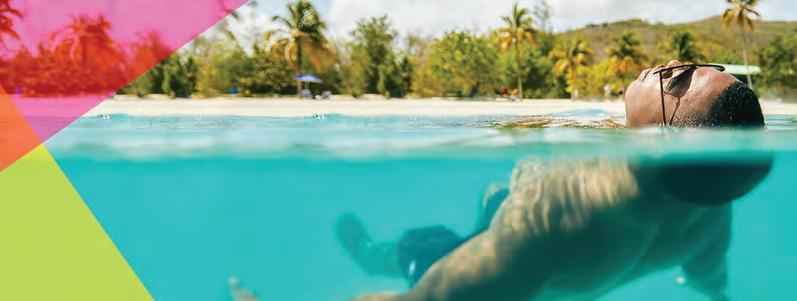
experience the islands’ natural cadence.


Culturally, the US Virgin Islands are equally in tune. e music, dance and festivals re ect a vibrant heritage rooted in African, European and Caribbean traditions. e spirited calypso beats and reggae rhythms are expressions of life's ongoing dance—celebrating resilience, community and joy. ese cultural expressions are an extension of the islands’ natural rhythm, showcasing how human life here moves seamlessly
with nature’s ow.
In a world o en dictated by chaos and rapid change, the US Virgin Islands serve as a reminder of the beauty of being in sync with nature’s tempo. eir natural, cultural and ecological rhythms o er a blueprint for sustainable living and harmony. As travelers and residents alike continue to embrace this rhythm, they uphold a legacy of balance—one that celebrates life’s natural ow and the enduring spirit of these remarkable islands. In the US Virgin Islands, being in rhythm isn’t just an ideal; it’s a way of life.
Learn more at www.VisitUSVI.com.





Buy One, Get One Free
Valued at over $90,000 MSRP, only 3000 tickets will be sold


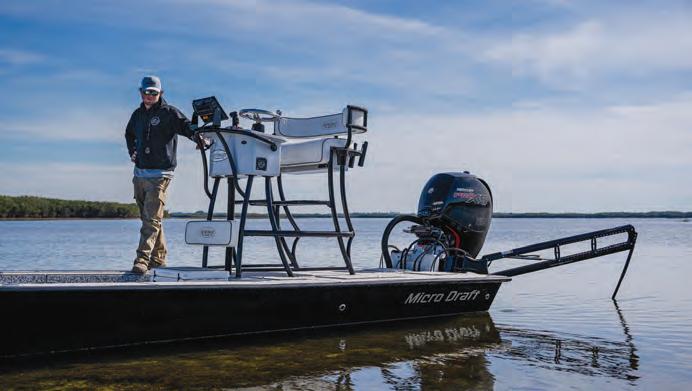



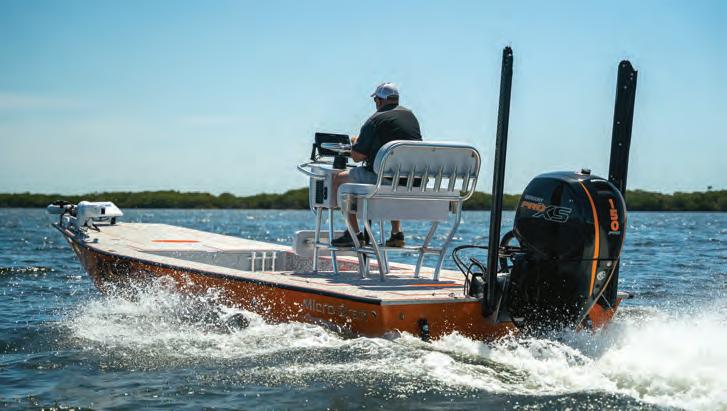




Tim Barefoot

September is a peculiar month. Some of the hottest days of the year, hurricane season is in full swing and the !rst northeast winds and cold fronts are about to occur. is is the time of year when wahoo and yellow!n can be caught right up against the beach on big schools of cigar minnows and sardines, or out in the deeper water. ere is no rhyme or reason to it this time of year; these !sh simply follow the bait schools
is is also the time of year when scamp grouper are very vulnerable. If you have the ability to keep a pin!sh trap in the water, it’s a good idea to take live pin!sh with you o shore for a number of reasons. One, pin!sh are very hearty and will live until the end of the day in the live well. Two, they are very sought a er by scamps because scamps view them as egg eaters and will kill them (eat them) so they don’t eat their eggs. And three, they are readily available at all !sh cleaning stations, at most marinas. Yes, I strongly suggest taking two or three boxes of frozen cigar minnows for bait, but live pin!sh are a ringer for scamps and other grouper/ snapper species in the deeper water.
with a cigar minnow. Proof is in the pudding...and here’s your proof. I’ve always said if you !nd the bait you !nd the !sh, and if you !nd big marks of bait (cigs, sardines, tinks, beeliners etc…) you’ll !nd the !sh. It’s always a good thing to have a “spotlight trolling motor” option to be able to sit on the bait or at least slow your dri in currents, but !sh under the bait on or near the bottom for grouper and snappers and keep the light line out for all the pelagics.
Designate one person in the crew to keep multiple light-line baits tended. Do not let this person get complacent and start bottom !shing. e same person should stay focused on the baits and working the Sabiki for whatever bait is below the boat. I’ve always said “Don’t walk in a Chinese restaurant and order a pizza,” meaning whatever is there is what they’re eating! A couple obvious execptions to this is pin!sh on the bottom and greenies/sardines; these baits are universal. We can’t keep gag grouper this time of year or American red snapper, but you can de!nitely !ll the box with other species.

September is when you will see all the tropical species in places you don’t normally see them. All the tropical snappers are everywhere now. Frozen cigar minnows on the Squid Decoy Jig are a wonderful option, but live cigs and sardines are a “whole nother story.” As shown in the photo, the all-time IGFA world record scamp was caught on the 12 ounce

Be ready for that big bite on the light line by choosing your tackle wisely as well. Yes, you need to keep the leader ( oro and wire) size small to get the bites, but use the correct size hooks, reel and line capacity to handle bigger !sh. Like I mentioned earlier, this is the time of year when wahoo are everywhere...and nowhere. You could catch a giant wahoo or tuna inshore, or in the deep water, just be prepared for it and be ready to chase it down if need be. e kite is always a great option if you have the team that can y the kite and bottom !sh simultaneously as it can be a challenge with wind speed, direction and current.
Learn more from Tim Barefoot on his YouTube channel and at barefootcatsandtackle.com.



















